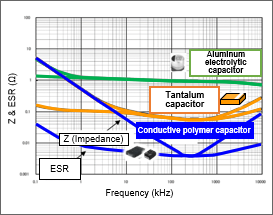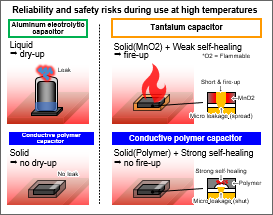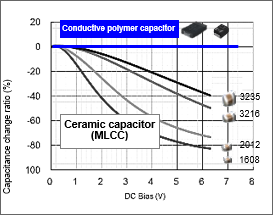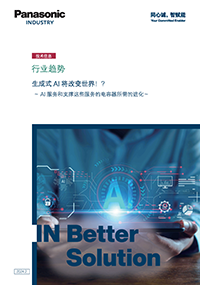Will Generative AI Drastically Change the World?
-The Evolution Required for AI Services and the Capacitors Supporting Them - (Second Part)
2024-02-22
In the previous post, we provided an overview of how generative AI services work, the issues they face, as well as examples of the hardware that makes up generative AI, with a focus on processors. In this article, we will discuss what kind of performance is required for capacitors, which contribute greatly to supplying power to processors for generative AI based on solutions actually used by our customers.
Importance of High-performance, High-quality Capacitors
Role of Capacitors in Processors
Capacitors are used in a variety of areas regarding hardware for generative AI and those used in the power lines of processors that perform key computational processes play a particularly important role. Just as a human needs food to move and think, a processor needs a sufficient supply of current to perform computational processing. The "power supply" is responsible for supplying this current. The current is carried through the power supply line to the processor, which often requires such high speeds and large currents that the power supply speed cannot keep up. If the supply fails to keep up, the voltage required for stable processor operation will drop significantly and operation of the processor will stop. As a result, the computational processes for learning and inference will also stop. In order to prevent such accidents, "capacitors" supply high-speed current to the processor. However, even when capacitors are installed, if their capacitance is insufficient, the voltage will drop for the same reason and the processor will stop operating (Figure 1-A).
Many of the processors used in generative AI require high current, and there is a concern that such conditions may actually occur. Thus, using large-capacitance capacitors such as Panasonic Industry's conductive polymer capacitors to supply sufficient current prevents voltage drops and enables the processors for the generated AI to continue long-term and stable computational processing. (Figure 1-B)
→ Current supply is insufficient and the voltage drops.
→ The voltage cannot be stabilized and it deviates from the acceptable range.
→ The system shuts down and data processing is aborted.

→ Sufficient current is supplied, preventing voltage drop.
→ The voltage remains at an acceptable range. = The voltage stabilizes.
→ Operation can smoothly transit to higher-speed processing.

Features of Conductive Polymer Capacitors and Their Contribution to Processors for Generative AI
<Comparison with other types of capacitors>
In power supply design, combining multiple capacitor types and ratings according to design requirements is considered as the optimal solution. What are the advantages of conductive polymer capacitors over other types of capacitors when they are used for processors for generative AI? Conductive polymer capacitors are recognized as very well-balanced capacitors, offering the general advantages of low ESR and high safety for general electrolytic and tantalum capacitors (Figure 2 left) as well as stable capacitance and a fewer number of components for ceramic capacitors (Figure 2 right). Due to these benefits, conductive capacitors are widely used in power supplies for processors for generative AI that require stringent electrical characteristics and reliability.
| General electrolytic and tantalum capacitors | Ceramic capacitor (MLCC) |
|---|---|
| One-digit lower ESR and impedance ➡Suppress voltage fluctuation at high-speed current Excellent safety ➡Contribute to highly-reliable design |
Stable high capacitance that is not influenced by voltage or temperature ➡Prevent voltage drop caused by insufficient power supply A fewer number of components ➡Contribute to simpler design |
  |
  |
Compact and Reduced Height
There is a tendency for AI processors to become larger each year as large currents are required to perform high computing capabilities. The size of power supplies is also increasing in order to satisfy demands for high currents. As a result, cases where there is not sufficient space to place capacitors on the board surface are increasing. To solve this problem, Panasonic Industry provides an abundant line-up of conductive polymer aluminum electrolytic capacitors (SP-Cap) with reduced height (2 mm or less) that can be placed on the back face of the board as an effective solution for the issue of implementation area which is worsening (Figure 3).

When capacitors can be placed on the surface, heat dissipation structures can be designed to be simple with high heat dissipation performance as compared to cases where tall capacitors are used, improving the reliability of hardware (Figure 4).

High Reliability
Another element prioritized in requirements for hardware for AI is long-term reliability. Especially during "learning" processes, processors continuously operate at their full capacity for long periods of time. For this reason, they are designed considering sufficient reliability so that they do not fail during operation. Requirements for the board temperature during long-term operation have become stricter than before in general as processors have increased in performance although they depend on the design of the heat dissipation structure and cooling method. Therefore, for peripheral parts, high heat resistance and long-term reliability are required. To respond to such hardware requirements, Panasonic Industry has developed conductive capacitors that can bear long-term use in high-temperature environments. They are effective options as capacitors for which reliability can be assured even when parts around the processors get hot. The figure below shows the comparison results of ESR and capacitance changes in a durability test (105℃, 2000 H) between conventional products and other companies' similar products. Although capacitors with the same capacitance and ESR specifications were selected, the results show a significant difference in voltage stabilization capacity after long-term use due to a difference in reliability. Characteristics of Panasonic Industry's conductive capacitors (SP-Cap) showed little change even after the test, indicating high reliability.


Points of Conductive Polymer Capacitors to Contribute to Hardware for Generative AI Overall
In servers used for conventional web services, 12 V power is typically supplied to processors from the AC/DC converter placed in a server rack. However, in servers used for generative AI, 48 V power is supplied in many cases as more processors are installed. This is because power distribution at 12 V generates extremely significant power loss while power distribution at 48 V can reduce the current to 1/4 and power loss to 1/16. In this case, the voltage for processors is converted from 48 V to an intermediate voltage through a DC/DC converter (1st stage) then into 1.x V or lower that processers use using the DC/DC converter (2nd stage) in the subsequent stage in general. To devices that use 12 V (e.g. PCIe and SSD), 12 V is distributed through a different DC/DC converter that converts 48 V.
As described above, our conductive polymer capacitors are used to supply high current to processors at high speed. When you look at the entire circuit, capacitors are placed for input/output of each power supply (DC/DC converter). These capacitors are placed in order to compensate for the delay in current supply from the input side and operate the system stably. In generative AI, a system shutdown due to power supply failure results in huge losses. So, securing reliability across the entire power supply circuit is one of the moist important matters in hardware design. As described above, our conductive polymer capacitors are effective options for hardware for generative AI overall as they provide features such as excellent safety and high reliability.

| Location of use | Bulk capacitor standard rating | Products | Points of contribution to design |
|---|---|---|---|
| (1) 1st stage input(40-60 V) |
47-100uF | E-cap  |
Reasonable price and high capacitance (There is a concern about temperature characteristics and capacitance degradation due to liquid electrolyte.) |
OS-CON  |
Temperature stability of all-solid, long operating life, and high reliability (E-cap cannot be used when reliability is prioritized.) | ||
Hybrid  |
Features in between E-cap and OS-CON due to being semisolid | ||
| (2) 1st stage output, 2nd stage input (5-15V) |
100-470uF | OS-CON  |
High-capacitance and high-ripple current characteristics are effective for great current fluctuation backup and smoothing the power supply. |
POSCAP  |
Parts that are 2 mm high are effective for great current fluctuation backup of high-density servers that require implementation on the back face of the board as well as accelerator cards. | ||
| (3) 2nd stage output (<1.xV) |
220-1000uF | SP-Cap  |
High capacitance and low ESR characteristic are effective for high current fluctuation backup. Parts that are 2 mm high are effective as they can be implemented on the back face while there is not sufficient space on the output board surface in many cases. |
POSCAP  |
Most suitable for high-density servers and accelerator cards as they are compact and high-capacitance. |
Summary
This document has introduced configuration examples of processors that play main roles in the evolution of hardware, which is key to the rapid development and common use of generative AI services. It also has introduced examples of our capacitors that significantly contribute to processors' computer processing performance. Panasonic Industry will continuously provide conductive polymer capacitors that meet hardware requirements such as area-saving and high reliability, contributing to the realization of stable operation of the constantly evolving generative AI hardware.
| Requirement | Hardware expectation | Contribution of conductive capacitors |
|---|---|---|
| (1) Space-saving | Although high current needs to be supplied, increasing the power supply area should be minimized due to a restriction for the board size. | High-capacitance and low ESR characteristics that can support high current are provided. There is an abundant line-up of products whose parts are 2 mm high that can be installed on the back face of the board. |
| (2) Reliability | Although circuit boards get extremely hot, they need to be operated continuously for a long period of time. | Long-term reliability is high as the capacitance does not degrade due to temperature or voltage. Line-up of highly reliable products has been enhanced to respond to demands for high temperature and long operating life. Most suitable products for <1.x V, 12 V, and 48 V respectively |
Related product information
Related information
- Will Generative AI Drastically Change the World? -The Evolution Required for AI Services and the Capacitors Supporting Them - (First Part)
- Solving Problems with MLCCs by Adopting Conductive Polymer Capacitors
- Case Examples of Replacing Switching Power Supply Input/Output Capacitors from MLCCs to Hybrid Capacitors


